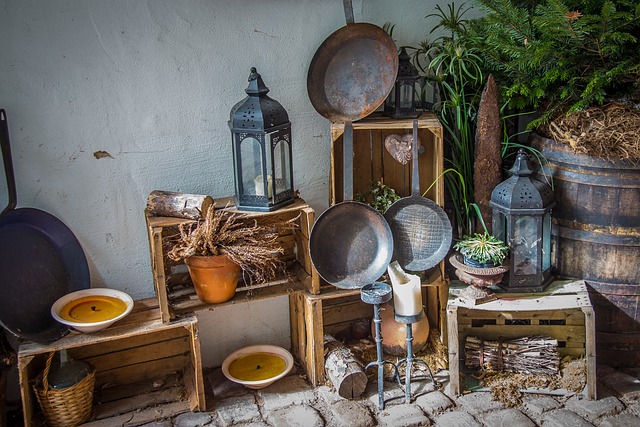Choosing the right kitchen flooring involves balancing durability, water resistance, aesthetics, and budget. Modern kitchen floor options include waterproof tile for humidity control, hardwood for natural beauty (with increased maintenance), cost-effective vinyl and laminate mimicking wood or stone, and eco-friendly laminates that resemble real wood without environmental impact. Each material offers unique characteristics catering to diverse preferences and needs in modern kitchens, emphasizing both functionality and style with sustainable choices available.
Looking to renovate your kitchen and want expert advice on flooring? This guide covers everything you need to know about kitchen flooring options. From understanding essential requirements to exploring modern and eco-friendly materials, we delve into the pros and cons of popular choices like tile, hardwood, vinyl, and laminate. Discover durable kitchen flooring that’s both stylish and waterproof, catering to various tastes and budgets.
- Understanding Kitchen Flooring Requirements
- Popular Durable Kitchen Floor Materials
- Exploring Modern & Eco-Friendly Options
- Tile, Hardwood, Vinyl, Laminate: Pros and Cons
Understanding Kitchen Flooring Requirements
When it comes to choosing kitchen flooring, understanding your specific needs is half the battle won. Kitchens are high-traffic areas subject to frequent cleaning and moisture exposure from sinks and appliances. Thus, durability and water resistance are key attributes sought after in kitchen flooring options.
Modern kitchen floor materials should ideally be able to withstand heavy footfall, resist stains, and be easy to maintain. Waterproof kitchen flooring is a popular choice for spaces with high humidity or direct water contact. Tile flooring for kitchens offers a wide array of designs and textures while remaining highly durable and low-maintenance. On the other hand, hardwood kitchen floors provide a classic aesthetic appeal but require more care to prevent water damage and scratching. Vinyl and laminate kitchen flooring are also popular choices, catering to those seeking cost-effective, eco-friendly (in the case of laminate) solutions that still offer durability and style.
Popular Durable Kitchen Floor Materials
When it comes to choosing a durable and stylish kitchen floor, there are several top options that offer both functionality and aesthetics. Tile flooring for kitchens is a popular choice due to its versatility and waterproof nature, making it an excellent pick for spaces prone to spills and moisture. Modern kitchen floor materials like hardwood and vinyl also stand out for their longevity and ability to withstand heavy foot traffic without showing signs of wear and tear.
Hardwood kitchen floors, in particular, add a touch of warmth and elegance to any space while remaining a robust option. Vinyl kitchen flooring is another game-changer, offering an extensive range of designs that mimic the look of wood or stone at a more affordable price point and with superior durability. For eco-conscious homeowners, laminate kitchen flooring provides an environmentally friendly alternative that resembles real wood without the same environmental impact, making it a smart choice for those seeking sustainable kitchen flooring options.
Exploring Modern & Eco-Friendly Options
When exploring kitchen flooring options, modern and eco-conscious homeowners have a plethora of durable kitchen flooring choices that blend style with sustainability. Tile flooring for kitchens offers both aesthetic versatility and practicality, with various materials like ceramic and porcelain boasting waterproof properties ideal for moisture-prone spaces. Hardwood kitchen floors remain a timeless classic, enhancing the natural ambiance while providing exceptional durability.
Alternative options include vinyl kitchen flooring, known for its affordability and ease of maintenance, along with laminate kitchen flooring that mimics the look of wood or stone at a lower cost. Each of these modern kitchen floor materials contributes to a reduced environmental impact, making them excellent choices for those seeking eco-friendly kitchen floors without compromising on style or functionality.
Tile, Hardwood, Vinyl, Laminate: Pros and Cons
When it comes to selecting kitchen flooring options, several materials offer a blend of style and functionality. Tile flooring for kitchens is a popular choice due to its durability and vast array of designs. It’s particularly suitable for wet areas, making it a top pick for modern kitchen floor materials that are also waterproof. However, tile can be cold underfoot and may require more maintenance compared to other options.
Hardwood kitchen floors exude warmth and natural elegance, making them a timeless choice. These eco-friendly kitchen floors are highly durable and can be sanded and refinished over time. Vinyl and laminate kitchen flooring offer cost-effective alternatives with similar water resistance. Vinyl is versatile and easy to install, while laminate mimics the look of hardwood at a lower price point. Laminate, however, may not be as durable or as easy to repair if damaged.
When selecting kitchen flooring, consider your lifestyle, budget, and design preferences. Durable options like tile, hardwood, vinyl, or laminate offer a range of pros, from ease of maintenance to long-term cost-effectiveness. For modern, eco-conscious choices, explore sustainable materials that blend style and functionality. Remember, the right floor can transform your kitchen into a functional space that’s both beautiful and practical.
